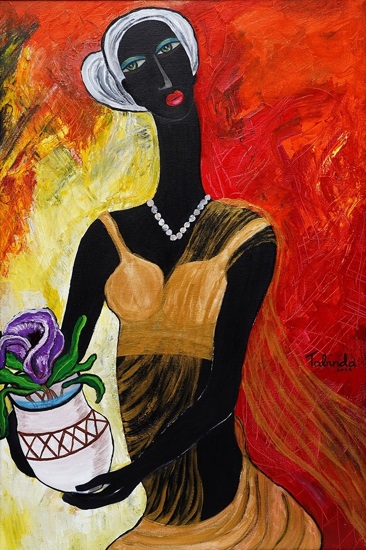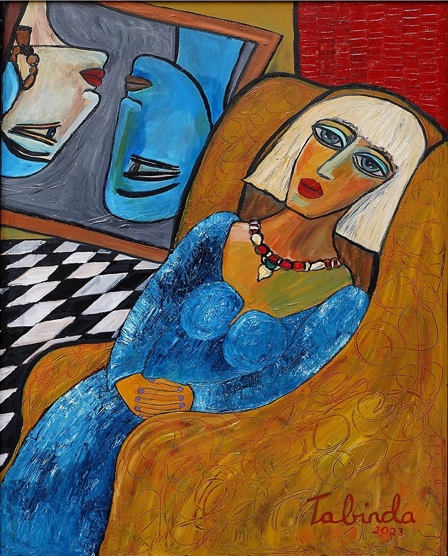Written by: Sana Shahid
Posted on: October 30, 2024 |  | 中文
| 中文
My Beautiful World - I by Tabinda Chinoy
Tabinda Chinoy’s artistry is a deeply immersive journey into cultural landscapes and human emotion, depicting her unique blend of vibrant aesthetics and abstract storytelling. Her recent exhibition, Through the Veil of Dreams, held at Gallery 6 in Islamabad, showcases her commitment as an artist to exploring themes of unity, identity and resilience. Chinoy, known for her bold and expressionistic approach, combines semi-abstract elements in her work to invite viewers to experience a world rich in both cultural symbolism and emotional depth. In this exhibition, she pushes the boundaries of expression further, drawing on Pakistan’s cultural fabric while creating a harmonious two-dimensional world where diversity is celebrated on a canvas. Each piece is a dialogue between the artworks and the viewer, with Chinoy offering glimpses of her vision while leaving space for an individual’s imagination.
Chinoy’s desire to reflect the lives and struggles of women has been a consistent theme throughout her series of exhibitions. Her work resonates with the nuances of the female experience, capturing moments of vulnerability, courage and strength. Her fascination with figurative forms, especially those depicting women, adds a personal and reflective quality to her paintings. For Chinoy, art becomes a voice for the silenced, a space where women can break free from the constraints of traditional and conservative societal norms. This deep engagement with the female psyche serves as both a celebration and critique of her cultural heritage, adding a layer of complexity to her work that shows how deeply Chinoy feels about the societal pressures and boundaries for women to follow with their heads held down.
In Through the Veil of Dreams, Chinoy moves beyond personal reflection to explore a broader realm where dreams take on a tangible form, a veil that once lifted, reveals a world filled with expression and freedom for the female gender. This dreamlike space flows through the exhibition, with Chinoy’s use of color, form and composition drawing viewers into a world where familiar symbols and structures interact in unexpected ways. By creating this, Chinoy invites her audience to envision a reality in which diverse communities represented by various religious and architectural symbols thrive together.
The central motif of buildings in this exhibition is a departure from her earlier works, which were primarily centered on the human figure. Here, she uses architecture as a metaphor for societal cohesion, blending religious symbols like mosques, churches, temples and synagogues with contemporary urban structures. These buildings, ranging from humble mud huts to towering skyscrapers, reflect humanity’s shared aspirations and needs. Her work suggests that each architectural structure, despite its unique background, fulfills a universal role as a place of gathering, refuge and worship.
This symbolic use of architecture offers a fresh perspective on integrating linear and geometrical shapes and forms that are used as an analogy for portraying the concept of commonality. Chinoy advocates for diversity through her artworks, a message that resonates deeply in the 21st Century when the world is dividing, separating and expressing anger. Her art challenges viewers to reconsider their perceptions of cultural and religious segregation. Her vision of inclusive harmony is both inspiring and provocative, serving as a reminder that peaceful coexistence is not only possible but deeply necessary.In addition to her architectural motifs, Chinoy’s use of color and texture is a critical component of her storytelling. Her choice of vibrant hues and layered brushstrokes brings energy to each piece, inviting viewers to feel the emotional resonance behind each scene. While her color palettes are bold, they are also purposeful, often reflecting a sense of optimism and hope. Each layer of color builds upon the previous one, creating a sense of depth and continuity, much like the layers of human experience. This approach adds a tactile dimension to her work, making each piece feel like an unfolding story from Pandora’s box rather than being a static image.
Chinoy hasn’t only limited her symbolism to architecture but also depicted natural imagery, like birds and fish. These motifs recur throughout her work, representing themes of freedom, resilience, and transformation. Birds, often depicted in flight, suggest an aspiration to transcend boundaries and soar beyond limitations, symbolizing the desire for liberation in both physical and metaphorical senses. Fish, meanwhile, embodies adaptability and endurance, thriving in diverse and challenging environments. Altogether, this symbolism is adhering to the same cause which is to see a world where unity prevails and diversity wins, a world full of love and care instead of conflict and hatred, a reality where exception is expected, and commonality takes a step back.
In Through the Veil of Dreams, Tabinda Chinoy redefines the boundaries of cultural and artistic expression, presenting an aspirational view of society that celebrates difference while emphasizing unity. Her work is not only a visual journey but a philosophical one, challenging the viewer to envision a world built on mutual respect and understanding. Through her art, Chinoy continues to inspire dialogue, reflection and hope, inviting each of us to look beyond the visible and imagine a world shaped by shared dreams and aspirations. Her exhibition leaves a lasting impression, affirming the role of art as a powerful force for connection, empathy and change.

Purple Flower

My Beautiful World - II

Unrequited Love
You may also like: